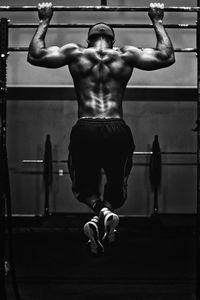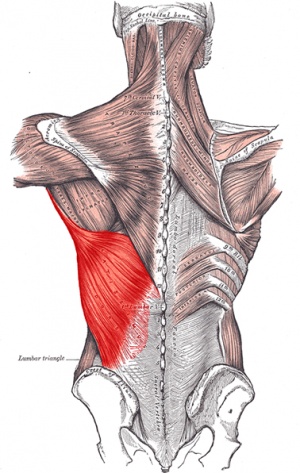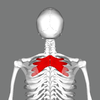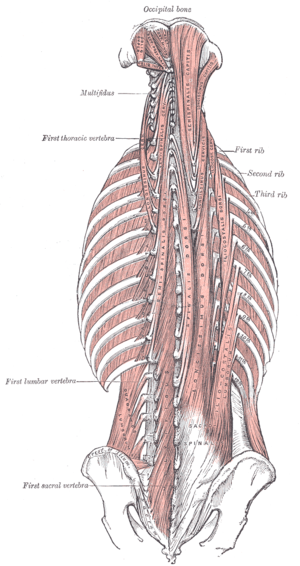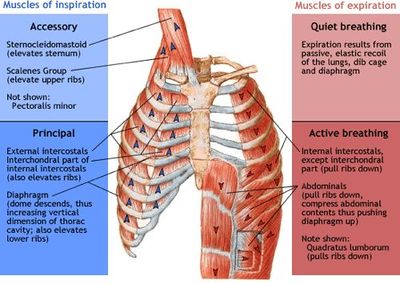Thoracic Spine Major Muscles: Difference between revisions
No edit summary |
No edit summary |
||
| Line 12: | Line 12: | ||
# Superficial back muscles - found just under the skin. Includes latissimus dorsi, the trapezius, levator scapulae and the rhomboids. Able to move the upper limb as they originate at the vertebral column and insert onto either the clavicle, [[scapula]] or [[humerus]]. | # Superficial back muscles - found just under the skin. Includes latissimus dorsi, the trapezius, levator scapulae and the rhomboids. Able to move the upper limb as they originate at the vertebral column and insert onto either the clavicle, [[scapula]] or [[humerus]]. | ||
#Intermediate back muscles - work to elevate and depress the [[Ribs|rib]] cage. There are two major muscles within this category – the serratus posterior superior and the serratus posterior inferior. | #Intermediate back muscles - work to elevate and depress the [[Ribs|rib]] cage. There are two major muscles within this category – the serratus posterior superior and the serratus posterior inferior. | ||
# Back muscles - Includes Erector Spinae and intrinsic back muscles | # Back muscles - Includes Erector Spinae and [[Transversospinales|Transversospinalis]] Group (intrinsic back muscles). These muscles collectively work to help movements of the vertebral column and to also control [[posture]].<ref>Teachmeanatomy [https://teachmeanatomy.info/back/muscles/ Back Muscles] Available from:https://teachmeanatomy.info/back/muscles/ (last accessed 8.5.2020)</ref> | ||
Not attached to the thoracic spine, but an important group of muscles in this region is the Intercostal Group ie External Intercostals; Internal Intercostals. | |||
== Major Muscles == | == Major Muscles == | ||
| Line 28: | Line 29: | ||
[[Serratus posterior|Serratus Posterior]] Inferior – is located at the junction of the thoracic and lumbar regions. It originates from vertebrae T12 down to L3 and inserts into the 9th through to 12th ribs. It acts to draw the lower ribs backwards and downwards and assists in trunk rotation and extension. It also helps with forced expiration. | [[Serratus posterior|Serratus Posterior]] Inferior – is located at the junction of the thoracic and lumbar regions. It originates from vertebrae T12 down to L3 and inserts into the 9th through to 12th ribs. It acts to draw the lower ribs backwards and downwards and assists in trunk rotation and extension. It also helps with forced expiration. | ||
'''3. Back Muscles'''[[File:Deep back muscles.png|right|frameless|566x566px]]1.Thoracic [[Erector Spinae]] – the main extensor (backward bending) muscle of the thoracic spine, located on either side of the vertebral column. | '''3. Back Muscles -''' The term paraspinal musculature is used to describe the erector spinae and the transversospinalis groups together'''.'''[[File:Deep back muscles.png|right|frameless|566x566px]]1.Thoracic [[Erector Spinae]] – the main extensor (backward bending) muscle of the thoracic spine, located on either side of the vertebral column. | ||
2. Intrinsic back muscles, named as such because their embryological development begins in the back, opposed to the superficial and intermediate back muscles which develop elsewhere and are therefore classed as extrinsic muscles | * The erector spinae is most massive in the lumbar and thoracic regions. In the lumbar region, it is deep to the latissimus dorsi; in the thoracic region, it is deep to the trapezius and rhomboids. Very little erector spinae is present in the neck<ref name=":0">Musculoskeletalkey [https://musculoskeletalkey.com/8-muscles-of-the-spine-and-rib-cage/ Muscles of the spine and rib cage] Available from: https://musculoskeletalkey.com/8-muscles-of-the-spine-and-rib-cage/ (last accessed 9.5.2020)</ref>. | ||
* The erector spinae is the principal musculature that works when we bend forward. It contracts eccentrically to guide our descent when we bend forward; it contracts isometrically when we hold a bentforward posture; and it contracts concentrically when we stand back up. When acting unilaterally (on only one side of the body) it assists with side bending and spinal rotation to the same side. | |||
2. [[Transversospinales|Transversospinalis Group]] – these shorter, deep muscles help stabilise the spinal segments. Intrinsic back muscles, named as such because their embryological development begins in the back, opposed to the superficial and intermediate back muscles which develop elsewhere and are therefore classed as extrinsic muscles | |||
* They are situated deep to the erector spinae, and run obliquely and makes up the mass of musculature that fills the laminar groove of the spine between the transverse and spinous processes. | |||
* The transversospinalis muscle group can be divided into three subgroups: from superficial to deep, they are the semispinalis, the multifidus, and the rotatores. | |||
* [[ | # The [[Transversospinales|Rotatores]] attach superiorly to the vertebrae one to two levels above the inferior attachment | ||
# The [[Lumbar multifidus|Multifidus]] attaches superiorly to vertebrae three to four levels above the inferior attachment | |||
# The [[Transversospinales|Semispinalis]] attaches superiorly to vertebrae five or more levels above the inferior attachment. | |||
* The multifidus is the largest muscle of the low back; the semispinalis is the largest muscle of the neck. Also credited, along with the transversus abdominis, as being one of the most important muscles of core stabilization. | |||
* As the multifidus attaches inferiorly to the iliac crest and sacrum, the transversospinalis group can help stabilize the sacroiliac joint. | |||
* Of the three subgroups of the transversospinalis, only the multifidus attaches onto the pelvis, and only the semispinalis attaches onto the head. <ref name=":0" /> | |||
'''The [[Muscles of Respiration|Intercostal]] Group''' | |||
[[File:949 937 muscles-of-respiration.jpg|right|frameless|400x400px]] | |||
The intercostal group is composed of the external intercostals and the internal intercostals. | |||
* Located in the anterior, lateral, and posterior thoracic region of the trunk. | |||
* Depending on the specific location, they may be deep to other muscles or they may be superficial and easily palpable. | |||
* The fibre directions of these two muscle groups are perpendicular to each other. | |||
* The fibre direction of the external intercostals is the same as the fibre direction of the external abdominal oblique | |||
* The fibre direction of the internal intercostals is the same as the fibre direction of the internal abdominal oblique<ref name=":0" />. | |||
== Clinical Implications == | == Clinical Implications == | ||
Revision as of 07:27, 9 May 2020
This article or area is currently under construction and may only be partially complete. Please come back soon to see the finished work! (9/05/2020)
Original Editor - Lucinda hampton
Top Contributors - Lucinda hampton and Kim Jackson
Introduction[edit | edit source]
The muscles of the back can be arranged into 3 categories based on their location:
- Superficial back muscles - found just under the skin. Includes latissimus dorsi, the trapezius, levator scapulae and the rhomboids. Able to move the upper limb as they originate at the vertebral column and insert onto either the clavicle, scapula or humerus.
- Intermediate back muscles - work to elevate and depress the rib cage. There are two major muscles within this category – the serratus posterior superior and the serratus posterior inferior.
- Back muscles - Includes Erector Spinae and Transversospinalis Group (intrinsic back muscles). These muscles collectively work to help movements of the vertebral column and to also control posture.[1]
Not attached to the thoracic spine, but an important group of muscles in this region is the Intercostal Group ie External Intercostals; Internal Intercostals.
Major Muscles[edit | edit source]
1. Superficial Layer:
Trapezius – this large back muscle attaches to the vertebral column from the base of the skull to the ligamentum nuchae of the neck, to the spinous processes of C7 and the thoracic spine down to T12. It connects the shoulder blade with the vertebral column and acts to support the arm and assist in upper limb movement by controlling shoulder blade movements.
Latissimus Dorsi – this broad back muscle runs from the spinous processes of the lower thoracic vertebrae and lumbar spine, the connective tissue (fascia) of the thoracolumbar region, as well as the pelvis and lower ribs, to insert into the upper arm bone (humerus). Its primary action is to extend, adduct and internally rotate the upper arm (i.e. bring the upper arm backwards, to the side of the body and rotate the upper arm towards the body e.g. performing a chin up). It also influences movements of the shoulder blade and trunk.
Rhomboids – these rhombus shaped muscles originate from the spinous processes of cervical and thoracic vertebrae (C7 to T5) and attach to the shoulder blade. The rhomboids main action is to pull the shoulder blades back (scapular retraction).
2. Intermediate Layer:
Serratus Posterior Superior – is a thin, quadrilateral shaped muscle, located at the upper and back part of the thoracic spine. It lies deep to the rhomboids and aids inspiration by elevating ribs 2 to 5 where it attaches.
Serratus Posterior Inferior – is located at the junction of the thoracic and lumbar regions. It originates from vertebrae T12 down to L3 and inserts into the 9th through to 12th ribs. It acts to draw the lower ribs backwards and downwards and assists in trunk rotation and extension. It also helps with forced expiration.
3. Back Muscles - The term paraspinal musculature is used to describe the erector spinae and the transversospinalis groups together.
1.Thoracic Erector Spinae – the main extensor (backward bending) muscle of the thoracic spine, located on either side of the vertebral column.
- The erector spinae is most massive in the lumbar and thoracic regions. In the lumbar region, it is deep to the latissimus dorsi; in the thoracic region, it is deep to the trapezius and rhomboids. Very little erector spinae is present in the neck[2].
- The erector spinae is the principal musculature that works when we bend forward. It contracts eccentrically to guide our descent when we bend forward; it contracts isometrically when we hold a bentforward posture; and it contracts concentrically when we stand back up. When acting unilaterally (on only one side of the body) it assists with side bending and spinal rotation to the same side.
2. Transversospinalis Group – these shorter, deep muscles help stabilise the spinal segments. Intrinsic back muscles, named as such because their embryological development begins in the back, opposed to the superficial and intermediate back muscles which develop elsewhere and are therefore classed as extrinsic muscles
- They are situated deep to the erector spinae, and run obliquely and makes up the mass of musculature that fills the laminar groove of the spine between the transverse and spinous processes.
- The transversospinalis muscle group can be divided into three subgroups: from superficial to deep, they are the semispinalis, the multifidus, and the rotatores.
- The Rotatores attach superiorly to the vertebrae one to two levels above the inferior attachment
- The Multifidus attaches superiorly to vertebrae three to four levels above the inferior attachment
- The Semispinalis attaches superiorly to vertebrae five or more levels above the inferior attachment.
- The multifidus is the largest muscle of the low back; the semispinalis is the largest muscle of the neck. Also credited, along with the transversus abdominis, as being one of the most important muscles of core stabilization.
- As the multifidus attaches inferiorly to the iliac crest and sacrum, the transversospinalis group can help stabilize the sacroiliac joint.
- Of the three subgroups of the transversospinalis, only the multifidus attaches onto the pelvis, and only the semispinalis attaches onto the head. [2]
The Intercostal Group
The intercostal group is composed of the external intercostals and the internal intercostals.
- Located in the anterior, lateral, and posterior thoracic region of the trunk.
- Depending on the specific location, they may be deep to other muscles or they may be superficial and easily palpable.
- The fibre directions of these two muscle groups are perpendicular to each other.
- The fibre direction of the external intercostals is the same as the fibre direction of the external abdominal oblique
- The fibre direction of the internal intercostals is the same as the fibre direction of the internal abdominal oblique[2].
Clinical Implications[edit | edit source]
Many thoracic spine problems are related to poor posture and/or muscle irritation or tension, also called myofascial pain.
These muscular problems can arise from eg.
- Sitting or standing in a slouched position over time.eg sway back
- Using a backpack.
- Sitting for a long time at a computer.eg forward head posture
- Lack of muscular strength (couch potatoes beware!).
- Repeating a movement persistently that involves the thoracic part of the spine (as in sport or work): also called overuse injury[3].
Resources[edit | edit source]
- bulleted list
- x
or
- numbered list
- x
References[edit | edit source]
- ↑ Teachmeanatomy Back Muscles Available from:https://teachmeanatomy.info/back/muscles/ (last accessed 8.5.2020)
- ↑ 2.0 2.1 2.2 Musculoskeletalkey Muscles of the spine and rib cage Available from: https://musculoskeletalkey.com/8-muscles-of-the-spine-and-rib-cage/ (last accessed 9.5.2020)
- ↑ Benchmark Physiotherapy Tx mid back pain Available from:https://www.benchmarkphysiotherapy.com.au/thoracic-mid-back-pain/ (last accessed 9.5.2020)
